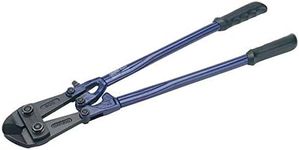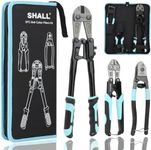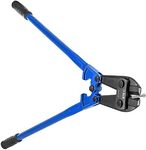Buying Guide for the Best Bolt Cutters
Choosing the right bolt cutters can make a significant difference in the ease and efficiency of your work. Bolt cutters are essential tools for cutting through heavy materials like chains, padlocks, and wire mesh. To find the best fit for your needs, you should consider several key specifications. Understanding these specs will help you make an informed decision and ensure that the bolt cutters you choose are suitable for the tasks you have in mind.SizeThe size of bolt cutters is measured by the length of the handles, which typically ranges from 12 inches to 42 inches. This spec is important because it affects both the cutting capacity and the leverage you can apply. Smaller bolt cutters (12-18 inches) are more portable and easier to handle, making them suitable for lighter tasks like cutting small bolts or wires. Medium-sized bolt cutters (24-30 inches) offer a balance between portability and cutting power, ideal for medium-duty tasks. Larger bolt cutters (36-42 inches) provide maximum leverage and cutting capacity, perfect for heavy-duty tasks like cutting thick chains or padlocks. Choose the size based on the type of materials you need to cut and the level of portability you require.
Cutting CapacityCutting capacity refers to the maximum diameter of the material that the bolt cutters can cut through. This spec is crucial because it determines the types of materials you can work with. Cutting capacities are usually listed in millimeters or inches. For light-duty tasks, a cutting capacity of up to 5mm (0.2 inches) is sufficient. For medium-duty tasks, look for a cutting capacity of 5-10mm (0.2-0.4 inches). For heavy-duty tasks, you will need bolt cutters with a cutting capacity of over 10mm (0.4 inches). Assess the thickness of the materials you plan to cut and choose bolt cutters with an appropriate cutting capacity.
Blade MaterialThe material of the blades affects the durability and cutting performance of the bolt cutters. Common blade materials include hardened steel, chrome vanadium steel, and tungsten carbide. Hardened steel blades are durable and suitable for general use. Chrome vanadium steel blades offer higher strength and resistance to wear, making them ideal for more demanding tasks. Tungsten carbide blades are extremely hard and can cut through the toughest materials, but they are also more expensive. Consider the frequency and intensity of your cutting tasks to determine the best blade material for your needs.
Handle Material and DesignThe material and design of the handles impact the comfort and ease of use of the bolt cutters. Handles are typically made from steel, aluminum, or fiberglass and may have rubber or plastic grips for added comfort. Steel handles are strong and durable but can be heavy. Aluminum handles are lighter and easier to maneuver but may not be as strong as steel. Fiberglass handles offer a good balance of strength and weight. Ergonomic handle designs with cushioned grips can reduce hand fatigue and improve control. Choose handles that feel comfortable in your hands and provide the right balance of strength and weight for your tasks.
AdjustabilitySome bolt cutters come with adjustable jaws, allowing you to change the cutting angle and optimize the tool for different materials. This spec is important for versatility and precision. Adjustable bolt cutters can be fine-tuned to provide the best cutting performance for various tasks, from cutting thin wires to thick bolts. If you need a versatile tool that can handle a range of materials, look for bolt cutters with adjustable jaws. However, if you primarily work with one type of material, a fixed-jaw model may be sufficient.















